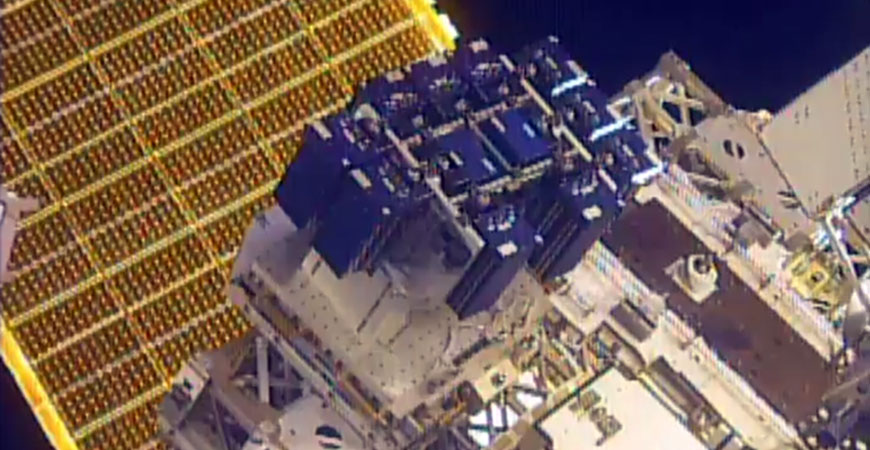
Solar films developed by a graduate student in the Department of Physics at UC Merced while on an internship at NASA Glenn Research Center (GRC) not only survived 10 months in space with minimal degradation, but the little damage they did incur was more than 90 percent reversible.
UC Merced researchers have published the surprising results of the first long-term study of perovskite solar samples in space — work done in collaboration with NASA GRC and the National Renewable Energy Lab (NREL) — in the journal Advanced Energy Materials.
Professor Sayantani Ghosh and her lab work with perovskites — hybrid organic-inorganic crystals used as the light-harvesting active layer in solar cells. They are cheaper and easier to produce than the prevalent silicon-based solar products.
“One of the big challenges with solar cells is that they are heavy, and NASA has been building them on Earth and then taking them into space,” Ghosh said. NASA aims to develop in situ manufacturing capability in the future when lunar habitats are established.
Ghosh’s lab developed a simple, efficient process for creating perovskite solar films called electrospraying. The method does not require gravity because it uses an electric field to guide the flow of the solvents and creates extremely smooth solar-energy-absorbing films. And while on Earth the perovskite crystals are vulnerable to moisture and oxygen, neither of those exist in space. That means, in theory, astronauts could produce their own solar panels in space.
But first, the researchers needed to know whether the films are viable in space.
More than a year ago, as part of the 13th Materials International Space Station Experiment (MISSE-13), NASA sent a perovskite sample to the International Space Station (ISS), where they were fixed to the outer surface for 10 months, exposed to temperature extremes of plus-minus nearly 100 degrees, direct radiation and other hazards of space.
They were returned to Earth and after several months of quarantine, researchers from UC Merced and NASA examined and tested them.
“This is a huge step forward in the effort to make perovskites in space a reality,” said William Delmas, an alumnus from Madera who worked in Ghosh’s lab throughout graduate school and created the samples at GRC. He graduated in 2022 and is now working as a postdoc at Sandia National Lab.
After Delmas produced the samples, they sat on the launchpad in Houston for six months, as all payloads that will be delivered to the ISS do.
“NASA wants to make sure there isn't any strange gas expulsion or anything that could cause problems either on the shuttle or the ISS,” Ghosh explained. “When the samples went up, they were mounted on an experimental cube that faces the sun, and they leave the cube outside for 10 months. It goes through night and day the same way the ISS does — 45 minutes of daylight, 45 minutes of night. It went through almost 5,000 of those cycles in the 10 months it was up there.”
Ghosh, Delmas, and two other graduate students who worked on the project, Samuel Erickson and Jorge Arteaga, were surprised by the condition of the samples when they came back to Earth.
“They sustained more damage sitting on the launchpad in Houston than they did on the ISS,” Ghosh said. “In space, you would expect the most damage to come from radiation. But this sample had a thin glass panel in front of it and that absorbed most of the high-energy radiation. The glass actually became yellow. The vacuum in space kept the sample safe. There was some strain on the crystal, but you couldn't see it. We only found it when we did some measurements, and after irradiating it, it recovered.
“In fact, in some cases it was better than the samples that had been left on the ground.”
Perovskite isn't known for its stability, she said, so the first and biggest worry was how long it would last in space and through all of the pre-launch protocol.
There are many further tests NASA and Ghosh will conduct with the perovskite samples, and they have already sent up many more samples on successive MISSE missions, including fully operational solar cells, this time to see what happens without the glass in front of the panels to protect them from direct radiation.
The samples should be back in the next couple of months, but in the meantime, other samples were sent to collaborators’ labs here on Earth to be exposed to powerful neutron and proton radiation.
“They didn't have any damage until we really cranked up the radiation levels, which tells us they will have a useful life in space before they eventually sustain irreparable damage,” Ghosh said. “We're looking at them lasting at least 10 years without significant radiation damage.”
While the researchers can look at some of the hazards the panels will face without sending them into space, there are unpredictable hazards that require the use of the ISS.
If everything works the way the researchers hope, astronauts could use electrospraying either on the space station or another kind of base camp, perhaps on the moon.
“With 1 liter of perovskite solution, we can make a football-field-sized sheet of solar absorbers in space — so if this works, we can have all the power we want in space, and the ability to make more,” Delmas said.
Lorena Anderson

Senior Writer and Public Information Representative
Office: (209) 228-4406
Mobile: (209) 201-6255






